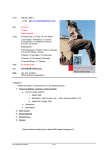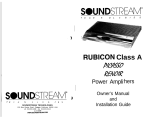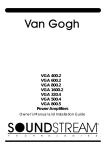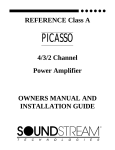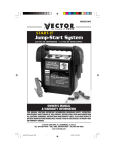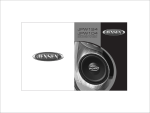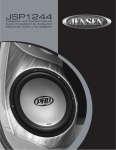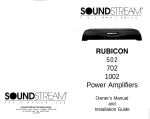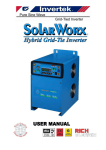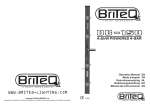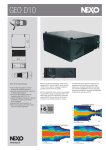Download Owner´s Manual and Installation Guide
Transcript
Owner´s Manual and Installation Guide CONGRATULATIONS! You now own the Limited Edition Tarantula Amplifier, the product of an uncompromising design and engineering philosophy. Your Soundstream Tarantula will outperform any other amplifier in the world. To maximize the performance of your system, we recommend that you thoroughly acquaint yourself with its capabilities and features.Please retain this manual and your sales receipt for future reference. Soundstream amplifiers are the result of American innovation and the highest quality control standards. When properly installed, they will provide you with many years of listening pleasure.Should your amplifier ever need service or replacement due to theft, please record the following information which will help protect your investment. Serial # Dealer's Name Date of Purchase Installation Shop Installation Date CAUTION! Prolonged listening at extremely high levels may result in hearing loss.Even though your new Soundstream Tarantula amplifier sounds better than anything you've ever heard, exercise caution to prevent hearing damage. 2 TABLE OF CONTENTS Features p 4 -5 Tarantula Diagram p6-7 Balanced/Unbalanced Inputs p8 Wiring p9 Installation and Mounting p 10 Crossover Adjustments p 11 Hawkins Bass Control™ Theory and Use p 12 ~ 13 Level Setting p 14 Power Supply Programming p 15 Troubleshooting Chart p 15 Sample System p 16 Protection Circuitry p 17 Very Serious Warnings p 17 Service p 17 Specifications p 18 3 FEATURES RUBI™ (Rapid-Use Branched Impulse) This new proprietary power supply topology eliminates “power sags"during low frequency reproduction by rapidly increasing the duty cycle, stabilizing the power supply and allowing it to deliver the power required when reproducing low frequencies. Also, greater reserve gate power is stored for low voltage conditions that occur during extreme conditions. STACT™(STabilized Apex Current Topology) Reduces power supply stress by 50%. In The STACT design, inversion is done at the power amplifier drive stage. Since the fully symmetrical power amplifier produces no even-harmonic distortion itself and all preamplifier circuitry is run completely inphase,no even harmonic distortion phase reversal occurs and power is better distributed throughout the amplifier. Advanced Trident™ Protection Topology Protects against potential harm/damage in the following situations: 1. Output Protection against short circuits or improper loads. 2. Voltage Inconsistencies protects against ground fault (speaker shorts to vehicle chassis) and an under/over voltage condition on the battery input. 3. Thermal Protection puts the amplifier into thermal rollback or shuts the amplifier down in extreme thermal conditions. Tone Sweep Calibration Routine Automatically configures and optimizes the power supply to the connected speaker load. Hawkins Bass Control Provides a focused parametric subwoofer boost (0 to +9 dB between 13-70 Hz) and routes otherwise wasted amplifier power back to the audible bandwidth. Continuously Variable Crossover Networks 24 dB/octave low pass crossovers variable from 35 Hz to 500k Hz with a range selection switch. Input Level Indicator A three colored LED that provides visual confirmation of the amplifier’s input level sensitivity setting. Output Clipping Indicators Indicates clipping on the output stage of the amplifier. Monitoring the clipping indicators allows the user to achieve maximum SPL without clipping the amplifier. Large Mouth Bass Remote subwoofer volume control built into the amplifier 4 FEATURES Output Phase Switch O-180 degree phase control switch. Fan Cooling With thermally sensitive speed control. Differentially Balanced RCA Input Eliminates ground loop related noise in the audio signal. Fully Balanced 6-pin DIN Input For professional quality performance and noise cancellation. The 6-pin DIN plug carries ( ) signal information for left and right channels, audio ground, and 15Vdc to operate the Soundstream BLT/ BLT4 Balanced Line Transmitters and Balanced X.0 crossover. RCA Line Output Provides a full range signal output to drive other amplifiers. Wire Connections Power and ground connections accept 1\0 gauge cable, while the speaker connections utilize dual 4 gauge connections. Harmonic Bass Alignment™ The 2nd and 3rd order harmonic peaks are critically aligned to fundamental peaks at low frequencies. This produces tighter,more accurate bass reproduction. Symmetrical Discrete Balanced Class A Drive Boards Auto-adjust for linear performance while driving low impedance loads. Drive Delay II™ Amplifier section powers up 2 to 3 seconds after the power supply, eliminating turn-on pops. Turn off process is reversed; amplifier section turns off first, followed by the power supply. Chassisink™ All transistors are ideally located and sandwiched between the circuit board and the heatsink to provide cool efficient amplifier operation. Dynamically Optimized Power Grid™ Power grid is evenly distributed between primary and secondary power supplies, providing greater dynamics and improved RF filtering. 5 TARANTULA DIAGRAM 6 KEY TO CALLOUTS 1. Input Level LED -Warns of the onset of clipping. 2. Amplifier Clip LED - Indicates clipped amplifier output. 3. Left Channel Balanced/ Unbalanced Input Switch -Select ‘Balanced’ to use the 6-pin balanced signal input. Select ‘Unbalanced’ to use the RCA signal inputs. 4. Right Channel Balanced/ Unbalanced Input Switch- Select ‘Balanced’ to use the 6-pin balanced signal input. Select ‘Unbalanced’ to use the RCA signal inputs. 5. Input Level- Input level control. 6. Hawkins Bass Control/ Subsonic Switch - Select ‘SUBSONIC’ to engage the Subsonic filter between 13 Hz and 30 Hz with no boost. Select Hawkins Bass Control’ to engage the Subsonic filter between30 Hz and 70 Hz with an adjustable boost determined with the Q boost control. 7. Hawkins/Subsonic Frequency Adjustment- Frequency adjustment control for the Hawkins Bass Control or the Subsonic filter. 8. Hawkins Bass Control Boost Adjustment - Varies from 0 to +9dB of boost when the Hawkins Bass Control circuit is engaged. 9. Low Pass Filter Adjustment - Frequency adjustment for the low pass filter. 10. Low Pass Filter Range Switch - Frequency range selection for the low pass filter. 11. Power/Calibration Switch- Push button switch that selects power level or when pushed and held for a short time, then released, the amplifier auto-adjust to the speaker load. 12. Phase Switch -Adjusts the speaker phase to either 0 or 180 degrees. 13. Power LED - Indicates amplifier power (see chart on page 16). 14. Status LED - Indicates amplifier status; thermal, short circuit, etc... 15. RCA Inputs - Right and Left channel RCA inputs. 16. Balanced Signal Input Connector - 6- pin balanced input connector for use with the Soundstream BLT/BLT4 Balanced Line Transmitter. 17. RCA Line Outputs - Right and Left channel RCA fullrange outputs. 18. Negative Speaker Terminals- Negative 4 gauge speaker connection. 19. GND - Main ground connection. Bolt to a clean chassis point in the vehicle. 20. Remote - Remote turn-on input from the head unit. Accepts 12V. 21. 12V - Connect to a fuse or circuit breaker, then to the batteryís positive terminal. 22. Positive Speaker Terminals - Positive 4 gauge speaker connection. 7 BALANCED/ UNBALANCED INPUTS The Tarantula has the ability to accept either a standard unbalanced RCA signal input, or a balanced “Pro Audio” style input signals with the use of the Soundstream BLT Balanced Line Transmitter or some other balanced line audio source. Before installing your system, you should decide upon which signal type you wish to run. The Tarantula’s signal input accepts a wide range of input level: from 300mV to 5.0V for both balanced and unbalanced inputs. For the best S/N Ratio, we recommend that the input level control be set as far down as possible (rotated counterclockwise), while maintaining an acceptable level of output. Using the “Unbalanced” RCA Input When using the unbalanced RCA input, the RIGHT channel input signal switch MUST be in the ‘UNBAL’ position. Also, when first installing the amplifier using this input configuration, we suggest that the left channel input signal switch be in the ‘UNBAL’ position as well. If you experience alternator whine or other installation noise with both switches in the ‘UNBAL’ position, try moving the LEFT channel input signal switch to the ‘BAL’ position. This should remove any system noise due to the installation. Using the “Balanced” Input When using the balanced B-pin DIN audio input, the switches MUST be in the ‘BAL ’ position. Also, we recommend that when using this input configuration, the input level control be set to the “minimum” position (rotated counterclockwise). The system gain should then be adjusted on the BLT Balanced Line Transmitter or other balanced line audio source. Advantages of using “Balanced” Inputs 1. Improved Signal to Noise Ratio (SIN Ratio). 2. Excellent noise cancellation characteristics. 3. Immune to noise radiated in the car audio environment. NOTE: The pin configuration shown in the diagram is the view looking into the Balanced input jack on the amplifier. 8 WIRING Power and Ground To ensure maximum output from your Tarantula amplifier, use high quality, Lowpass power and ground cables and connections. The Tarantula amplifier will accept up to 1/0 gauge power and ground cables. Circuit Breakers and Fuses External Like all audio components, the Tarantula amplifier must be fused near the battery. A 300 amp fuse or circuit breaker must be located within 18” of the battery. This will prevent a fire in the event of a shorted cable. Internal The Tarantula amplifier is fused with a 300 amp blade-type (ANC) fuse. In the event of a blown power supply fuse, replace with the correct value fuse. Never replace the fuse with a higher value than what is supplied. This may result in amplifier damage and will void the warranty! Remote Turn-On Connect the turn-on lead from the source unit to the ìRemoteî input on the amplifier. When +12 volts is received, the amplifier will turn on. Signal Cable Depending on your application, you may use either the DIN audio balanced signal cable or standard RCA cables to drive your Tarantula amplifier. Speaker Cable The Tarantula will accept up to a 4 gauge speaker cable. Use high quality, flexible, multi-strand cable for best performance and longevity. 9 INSTALLATION AND MOUNTING Amplifier Location The Tarantula amplifier employs highly efficient circuitry, a custom-engineered heatsink, and a unique Chassisink™ construction to maintain lower operating temperatures. Additional cooling may be required if the amplifier is located in a tightly confined area or when driving especially low impedance loads at extremely high levels. When mounting the amplifier, it should be securely mounted to a panel in the vehicle or an amp board or rack that is securely mounted to the vehicle. The mounting location should be either in the passenger compartment or in the trunk of the vehicle, away from moisture, stray or moving objects, and major electrical components. To provide adequate ventilation, mount the amplifier so that there are at least four inches of freely circulating air above it and at the intake vents on each side of the amplifier. Mounting The Amplifier a. Using the amplifier as a template, mark the cut out on the mounting surface. b. Remove the amplifier and cut out the hole to mount the amplifier. c. Secure the amplifier to the mounting surface using the supplied hardware. Wiring a. Run and connect the audio signal and remote turn-on cables to the amplifier from the source unit. b. Carefully ’run the positive cable from the amplifier to a fuse or circuit breaker within 18” of the battery. c. Connect the fuse or circuit breaker lead to the battery. Leave the circuit breaker off or the fuse out until everything is bolted down. d. Secure the ground cable to a solid chassis ground on the vehicle. It may be necessary to sand paint down to raw metal for a good connection. e. Double check each and every connection! f. Reconnect the fuse or circuit breaker. Power Up Power up the system, there may be a 2-3 second delay from the time the source unit is turned on to the time that the amplifier turns on, which is normal. Once the amplifier LED is on and the source unit is playing, you should have sound coming from the speakers. 10 CROSSOVER ADJUSTMENTS The Tarantula amplifier incorporates two separate electronic crossovers. A 12dB\octave Subsonic filter and an on-board 24 dB\octave electronic low pass crossover, with full range RCA outputs to drive an external amplifier. No external electronic crossover is required when operating this amplifier. Subsonic The Subsonic filter allows the amplifier to focus all of its energy where it is needed most. Adjust the filter to the tuning frequency of a ported box and increases in output will be noticed immediately. The Subsonic filter is variable from 13 to 30 Hz. The shaded area below shows the frequency and range adjustments as they appear on the control panel of the amplifier. Low Pass The Low Pass filter is variable from 35 to 500 Hz, which is divided into two separate ranges: “Low” and “High”. The “Low” range will yield a frequency range from 35 to 135 Hz, while the “High” is from 135 to 500 Hz. The shaded area below shows the frequency and range adjustments as they appear on the control panel of the amplifier. 11 HAWKINS BASS CONTROL™ THEORY AND USE Hawkins Bass Control (parametric) is a unique subwoofer control circuit included with the Tarantula amplifier. It is capable of removing subsonic energy in program material while boosting subwoofer frequencies. The circuit consists of two controls. One adjusts the frequency of operation and the other adjusts the range of boost. With both controls adjusted fully counterclockwise, no boost is applied and the amplifier is flat in response down to 20 Hz. The frequency control (Hz) adjusts the starting point of the subsonic filter. On the Tarantula, the high pass filter has two frequency ranges. When the bass control switch is set to ‘SUBSONIC’, the high pass filter frequency can be adjusted from 13 Hz up to a maximum of 30 Hz. In this setting, no boost “Q” control is available. This control is useful for setting the lowest frequency that your subwoofer will see. When the bass control switch is set to ‘HAWKINS BASS CONTROL’, the high pass filter frequency can be adjusted from 30 Hz to a maximum of 70 Hz. In this setting, there is an available boost control of 0 to +9dB. Fig. 1 Variable “Q” Fig. 2 Variable High Pass The Boost control adjusts the level applied at the set frequency. This is adjustable from flat 0 dB to + 9dB (See figure 1). When the ‘Boost’ is set to 0, Hawkins acts as a subsonic filter only (See figure 2). The simple act of removing potentially harmful low frequencies can improve system output by as much as 3 dB (See figure 3.) Fig. 3 Variable Boost 12 Application Subwoofers in general have excellent power handling characteristics over their operational bandwidth. This bandwidth is determined by many factors, including driver design, and enclosure type. It is possible to overdrive any subwoofer by sending powerful signals outside of its operational bandwidth. These potentially damaging signals can be removed by adding a subsonic filter. Figure 4 shows the effectiveness of the Hawkins Bass Control on woofer excursion in a vented enclosure. The woofer travels 7.5 mm at 10 Hz. With Hawkins Bass Control properly adjusted, this excursion can be reduced to less than 1 mm. This is of great benefit to lowering woofer distortion and increasing output. Fig.4 Limited Excursion Adjustment An easy method of optimizing your existing subwoofer enclosure with Hawkins ‘Hz’ control is as follows (assuming the audio system is already turned on). 1. Adjust frequency and boost control to full counterclockwise position. 2. Set the bass control switch to ‘HAWKINS BASS CONTROL’. 3.While listening to music with strong bass content at a moderate level, slowly adjust frequency control clockwise. Listen for a reduction of bass response. Now, rotate frequency control slightly backwards. This serves the purpose of removing the ‘subsonic’ bass energy. With Soundstream’s Hawkins Bass Control, the boost and frequency control can provide virtually any combination of boost and cut to suit your designs. So, Hawkins Bass Control can provide the ‘tailoring’ needed for any type of ‘assisted’ design and any woofer in any type of installation. The shaded area below shows the Hawkins Bass Control adjustments, crossover range switch and frequency as they appear on the control panel of the amplifier. 13 LEVEL SETTING The input level is adjusted by means of the input level control located on the control panel of the amplifier. This is a unique dual-stage circuit that adjusts both level and gain. This topology maintains better S/N Ratio even when using sources with minimal output. In the ideal situation, all components in the audio system reach maximum undistorted output at the same time. If you send a distorted signal to an amplifier, it is simply going or crossover begins to distort before you have maximum output from the amplifier. By setting all components to reach clipping at the same time, you can maximize the output of your system. For the Tarantula, follow these steps for setting the input levels: 1. Turn the amplifier’s input level to minimum position (counterclockwise). 2. Set the source unit volume to approximately 3/4 of full volume. 3. While playing dynamic source material, slowly increase the amplifier’s input level until a near maximum undistorted level is heard in the system. This can be visually verified by the input level indicator. The0 input level light has three levels of indication; Green (normal), Amber (1 0dB below clipping), Red (near clipping). The clipping indicator on the top of the amplifier will let you know when the output of the amplifier is reaching its maximum level, and has begun to clip. The shaded area below shows the input and output clip indicators, Large Mouth Bass switch and input level as they appear on the control panel of the amplifier. 14 POWER SUPPLY PROGRAMMING Push Buttons Power / Calibration Momentary Press (less than half second) Go to next speaker load power level 4 0HM (Red) 2 0HM (Amber) 1 0HM (Green) Hold and Release (more than second) Automatically set the power level by running the speaker load calibration routine. TROUBLE SHOOTING CHART Condition Normal Thermal Rollback Power LED Red Amber Green (4 ohm) (2 ohm) (1 ohm) Red Amber Green (4 ohm) (2 ohm) (11 ohm) Status LED off Blip (On: o.1 sec., Off: 1.9 sec.) Under I Over Battery Input voltage off Fast Blink (On: o.05 sec., Off: 0.1 sec.) Short Circuit /Overload off Medium Blink (On: o.05 sec., Off: 0.1 sec.) Over Temperature, Ground Fault, Tun On / Off off On NOTE: At low signal levels the INPUT LEVEL LED is variable green in color. With greater signal level the INPUT LEVEL LED begins to appear amber approximately 10dB below amplifier output clip. With extreme signal levels the INPUT LEVEL LED snaps red within 0.5dB of amp output clip. Amplifier output clipping can be identified by a solid red AMP CLIP LED. The 1 ohm power level is not a recommended set up for full power output; at times of reduced volume the 1 ohm power level can be used with actual 2 or 4ohm speaker loads to save energy draw from the vehicleís electrical system (i.e.extend battery life). 15 SAMPLE SYSTEM 16 PROTECTION CIRCUITRY Your Tarantula is protected against both overheating and short circuits by means of a main power fuse and the following circuits: Under/ Over battery input voltage (between 8.5Vdc and 17.0Vdc) Speaker Output Protection Ground Fault Differential Variable speed fan cooling with smart power supply thermal roll back Temporary over temperature shutdown with high speed fan cooling SERIOUS WARNINGS IMPORTANT(VERY)!!! If you experience blown main powers supply fuses it is likely that the amplifier is seeing a dead short either in the speaker wire or in the speaker itself. Rectity the problem before blowing multiple fuses! DO NOT increase valuse beyond the origianl fuse value! Doing so will void your warranty and may damage your amplifier. IMPORTANT(VERY VERY)!!! When the signal is being greatly amplified care must be taken while handling the speaker leads which may present potentially lethal voltages (possibly exceeding 100Vrms at clip) SERVICE Your Soundstream Tarantula is protected by a limited warranty. If an authorized dealer installs the amplifier, it is under warranty for a period of three years, a consumer installed unit is warrantied for a period of one year. Please read the enclosed warranty card for more details and be sure to send it in. ** NOTE ABOUT THE LIMITED WARRANTY** If the handles or the top of the amplifier are removed for any reason, the warranty will be void. There are no user serviceable parts in the amplifier this eliminates the need to ever open the top of the unit. 17 SPECIFICATIONS POWER 4 Ohm Mono (12.6Vdc) 4 Ohm Mono (14.4 Vdc) 2 Ohm Mono (14.4 Vdc) Maximum Rated Output 2000W x 1 2000W x 1 2000W x 1 2000Watts Tarantula T.H.E Signal to Noise Ratio Frequency Damping input Sensitivity Input Impedance <0.3% >90 dB 20Hz ( 0.5dB) to 500 Hz (-3 dB) >200 300mV to 5.0V 10k Ohms Crossover Specifications 24dB/octave Low Pass filter adjustable from 35 to 135 Hz(lower setting) 24 dB/octave Low Pass filter adjustable from 135 to 500 Hz (higher setting) Subsonic Filter No boost; 12 dB/octave High Pass filter from 13 to 30 Hz. Hawkins Bass Control 0 to +9dB boost; Boost and Subsonic filter variable from 30 to 70 Hz. Dimensions (W x D x H) Tarantula: 19.0¨ X 14¨ X 5.5¨ 18 SOUNDSTREAM TECHNOLOGIES 1550 Maple Avenue., Montebello, CA90640 U.S.A. Phone 323-722-3333 fax. 323-722-1122




















